1.集合的概念
-
概念:对象的容器,定义了对多个对象进行操作的常用方法。可以实现数组功能。
-
和数组的区别:
- 数组长度固定,集合长度不固定
- 数组可以存储基本类型和引用类型,集合只能存储引用类型
-
位置:java.util.*
2.Collection接口
2.1Collection体系集合
- Collection是根接口(父接口)
- List接口:有序、有下标、元素可重复
- Set接口:无序、无下标、元素不能重复
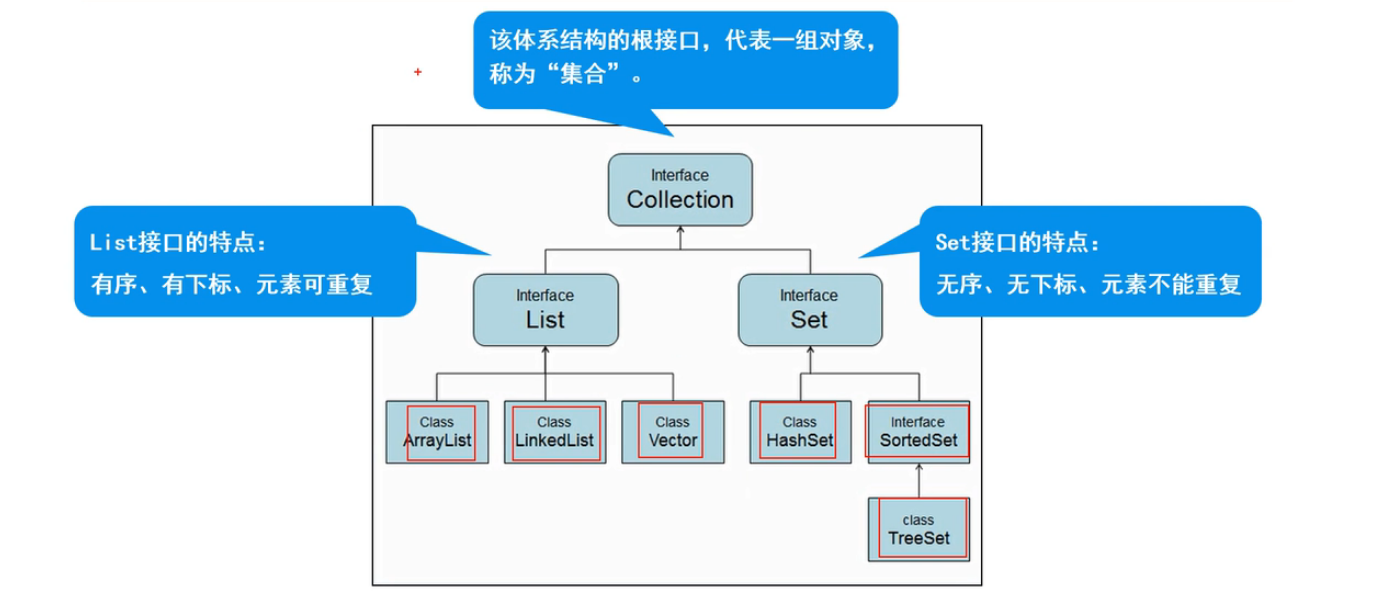
2.2Collection父接口
- 特点:代表一组任意类型的对象,无序、无下标、不能重复----无下标代表不能for循环,但可以foreach
- 方法:
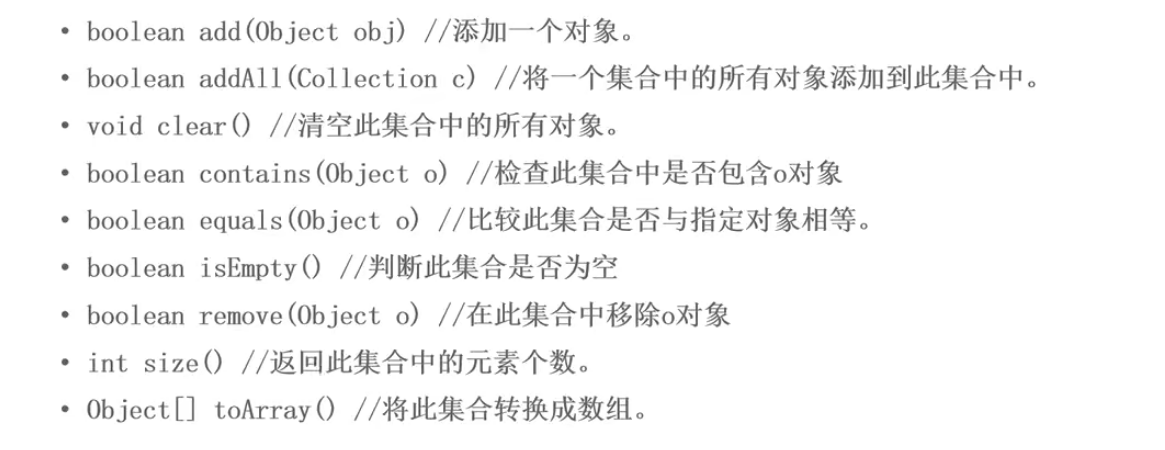
(1)实例一,以String类型为集合元素
package com.song.demo01;
import java.util.ArrayList;
import java.util.Collection;
import java.util.Iterator;
/**
* Collection接口的使用:
* (1)添加元素
* (2)删除元素
* (3)遍历元素
* (4)判断
*/
public class demo01 {
public static void main(String[] args) {
//创建集合
Collection collection = new ArrayList();//要new实现类,不能new接口!
//* (1)添加元素
collection.add("苹果");
collection.add("橙子");
collection.add("西瓜");
collection.add("草莓");
collection.add("柚子");
System.out.println("元素个数:" + collection.size());
System.out.println("集合元素:" + collection.toString());
//* (2)删除元素
collection.remove("草莓");
System.out.println("删除之后:");
System.out.println("元素个数:" + collection.size());
System.out.println("集合元素:" + collection.toString());
//* (3)遍历元素【重点】
//3.1方式一:使用增强for
for (Object object : collection) {
System.out.println(object);
}
//3.2方式二:使用迭代器(专门用来遍历集合的方式)
Iterator it = collection.iterator();//返回值是一个接口类型
/*
Iterator有三个方法:
1)hasNext();有没有下个元素
2)next();获取下个元素
3)remove();删除当前元素
*/
while (it.hasNext()) {
String str = (String) it.next();//若已知类型,可以做强转
System.out.println(str);
//collection.remove("柚子");//提示:迭代过程中不能使用Collection的方法改变元素
it.remove();//迭代过程中删除元素的方法
}
System.out.println("元素个数:" + collection.size());
// * (4)判断
System.out.println("判断是否有西瓜:" + collection.contains("西瓜"));
System.out.println("判断是否为空:" + collection.isEmpty());
}
}
(2)实例二:以Student对象为集合元素
package com.song.demo01;
//学生类
public class Student {
private String name;
private int age;
public Student(String name, int age) {
this.name = name;
this.age = age;
}
public String getName() {
return name;
}
public void setName(String name) {
this.name = name;
}
public int getAge() {
return age;
}
public void setAge(int age) {
this.age = age;
}
@Override
public String toString() {
return "Student{" +
"name='" + name + '\'' +
", age=" + age +
'}';
}
}
package com.song.demo01;
import java.util.ArrayList;
import java.util.Collection;
import java.util.Iterator;
//Collection的使用
public class demo02 {
public static void main(String[] args) {
//新建Collection对象
Collection collection = new ArrayList();
Student s1 = new Student("zhangsan", 29);
Student s2 = new Student("lisi", 18);
Student s3 = new Student("wangwu", 20);
Student s4 = new Student("lala", 24);
//1.添加数据
collection.add(s1);//实际往集合中添加的是堆中对象的地址!
collection.add(s2);
collection.add(s3);
collection.add(s4);
//collection.add(s3);//可以重复
System.out.println("元素个数:" + collection.size());
System.out.println(collection.toString());
//2.删除
/*collection.remove(s1);
//collection.remove(new Student("lisi",18));//不能删除,new出的对象与原有集合中的对象不同
collection.clear();//清除所有对象,只是将集合中的地址清除了,原有对象仍然在堆中
System.out.println("元素个数:" + collection.size());
*/
//3.遍历
//3.1增强for
for (Object obj : collection) {
Student s = (Student) obj;
System.out.println(s.toString());
}
//3.2迭代器:迭代过程中不能出现collection的删除方法
Iterator iterator = collection.iterator();
while (iterator.hasNext()) {
Student s = (Student) iterator.next();
System.out.println(s.toString());
}
//4.判断
System.out.println("集合中是否有元素:" + collection.contains(s2));//true
System.out.println("集合中是否有元素:" + collection.contains(new Student("lisi", 18)));//false
System.out.println("集合是否为空:" + collection.isEmpty());
}
}
2.3List子接口与实现类
2.3.1List接口
-
特点:有序,由下标,元素可以重复
-
方法

-
List接口继承了Collection,因此其包含Collection中的所有方法。
-
List是有序Collection,可以通过下标控制元素位置。
(1)实例一:字符串类型的List
package com.song.demo02;
import java.util.ArrayList;
import java.util.Iterator;
import java.util.List;
import java.util.ListIterator;
//List的使用
//特点:有序、有下标、元素可重复
public class Demo01 {
public static void main(String[] args) {
//创建集合
List list = new ArrayList();
//1.添加元素
list.add("小米");
list.add("华为");
list.add(0, "苹果");//指定位置添加
System.out.println("集合元素个数:" + list.size());
System.out.println(list.toString());
//2.删除元素
/*list.remove("苹果");
list.remove(0);//指定下标删除
System.out.println("删除之后集合元素个数:"+list.size());
System.out.println(list.toString());
*/
//3.遍历
//3.1使用for
System.out.println("-----------3.1使用for--------------");
for (int i = 0; i < list.size(); i++) {
System.out.println(list.get(i));
}
//3.2使用增强for
System.out.println("-----------3.2使用增强for--------------");
for (Object obj : list) {
System.out.println(obj);
}
//3.3使用迭代器
System.out.println("-----------3.3使用迭代器--------------");
Iterator it = list.iterator();
while (it.hasNext()) {
System.out.println(it.next());
}
//3.4使用列表迭代器
System.out.println("-----------3.4使用列表迭代器--------------");
//列表迭代器:允许按任意方向(向前、向后)遍历列表、迭代期间修改列表,并获得迭代器在当前列表的位置
ListIterator listIterator = list.listIterator();
System.out.println("-------从前往后------");
while (listIterator.hasNext()) {
System.out.println("下标:" + listIterator.nextIndex());
System.out.println(listIterator.next());
}
//默认指针是指向第一个元素的,只能从前往后,要想从后往前需要将指针移到最后
System.out.println("-------从后往前------");
while (listIterator.hasPrevious()) {
System.out.println("下标:" + listIterator.previousIndex());
System.out.println(listIterator.previous());
}
//4.判断
System.out.println("判断元素是否存在:" + list.contains("华为"));
System.out.println("判断是否为空:" + list.isEmpty());
//5.获取元素位置
System.out.println(list.indexOf("华为"));
}
}
(2)实例二:数字类型的List
package com.song.demo02;
import java.util.ArrayList;
import java.util.List;
//List的使用
public class Demo02 {
public static void main(String[] args) {
//创建集合
List list = new ArrayList();
//1.添加数字数据,隐含自动装箱操作
//集合中不能添加基本类型,基本类型需要自动装箱成包装类
list.add(20);
list.add(10);
list.add(24);
list.add(26);
System.out.println("元素个数:" + list.size());
System.out.println(list.toString());
//2.删除数字
/*list.remove(0);//数值类型的集合,根据下标删除
list.remove((Object) 10);//若要根据数值删除,转成Object对象或者Integer对象
list.remove(new Integer(26));
System.out.println("元素个数:" + list.size());
System.out.println(list.toString());
*/
//3.补充方法subList();返回子集合
List sublist = list.subList(1, 3);//从1开始到3前,左闭右开
System.out.println("元素个数:" + sublist.size());
System.out.println(sublist.toString());
}
}
2.3.2List实现类
-
ArrayList【重点】
- 数组结构,查询快、增删慢;
- JDK1.2版本,运行效率快、线程不安全。
-
Vector
- 数组结构,查询快、增删慢;
- JDK1.0版本,运行效率快、线程安全
-
LinkdedList
- 链表结构,增删快、查询慢
(1)ArrayList
源码分析:
-
DEFALUT_CAPACITY=10; 默认容量 --向集合添加元素后,默认容量为10
- 注意:如果没有向集合中添加任何元素是,集合容量为0
- 向集合添加任意一个元素后,集合容量变为10
- 添加第11个元素时,集合容量变为15
- 每次扩容,是原来的1.5倍
-
elementData; 存放元素的数组
-
size 实际元素个数
public boolean add(E e) {
ensureCapacityInternal(size + 1); // Increments modCount!!
elementData[size++] = e;
return true;
}
private static int calculateCapacity(Object[] elementData, int minCapacity) {
//初始创建时,均为空,条件成立,返回的是默认容量10
if (elementData == DEFAULTCAPACITY_EMPTY_ELEMENTDATA) {
return Math.max(DEFAULT_CAPACITY, minCapacity);
}
return minCapacity;
}
private void ensureCapacityInternal(int minCapacity) {
ensureExplicitCapacity(calculateCapacity(elementData, minCapacity));
}
private void ensureExplicitCapacity(int minCapacity) {
modCount++;
// overflow-conscious code
if (minCapacity - elementData.length > 0)
grow(minCapacity);
}
//核心部分:数组扩容的代码
//初始minCapacity=10
private void grow(int minCapacity) {
// overflow-conscious code
int oldCapacity = elementData.length;//0
int newCapacity = oldCapacity + (oldCapacity >> 1);//右移一位,相当于除以2
if (newCapacity - minCapacity < 0)
newCapacity = minCapacity;//10
if (newCapacity - MAX_ARRAY_SIZE > 0)
newCapacity = hugeCapacity(minCapacity);
// minCapacity is usually close to size, so this is a win:
elementData = Arrays.copyOf(elementData, newCapacity);//即当添加任意一个元素后,初始容量变为10
}
实例:
提示:若想根据对象值进行删除、查找等,需要重写equals()方法,因为equals()方法默认比较的是对象地址,而非对象中的属性值。
package com.song.demo02;
import java.util.Objects;
//学生类
public class Student {
private String name;
private int age;
public Student(String name, int age) {
this.name = name;
this.age = age;
}
public String getName() {
return name;
}
public void setName(String name) {
this.name = name;
}
public int getAge() {
return age;
}
public void setAge(int age) {
this.age = age;
}
@Override
public String toString() {
return "Student{" +
"name='" + name + '\'' +
", age=" + age +
'}';
}
@Override
public boolean equals(Object obj) {
//1.判断是不是同一个对象
if (this == obj) {
return true;
}
//2.判断是否为空
if (obj == null) {
return false;
}
//3.判断是否是Student类型
if (obj instanceof Student) {
Student stu = (Student) obj;
//4.相同类型则比较属性
if (this.name.equals(stu.getName()) && this.age == stu.getAge()) {//字符串的比较不能用==,要用equals
return true;
}
}
//5.不满足条件返回false
return false;
}
}
package com.song.demo02;
import java.util.ArrayList;
import java.util.Iterator;
import java.util.ListIterator;
//ArrayList的使用
//存储结构:数组-->查找遍历速度快,增删慢
public class Demo03 {
public static void main(String[] args) {
//创建集合
/**size=0 初始创建,容量为0;
* 向集合中添加任意一个元素后,容量变为10
* 后续添加的元素超过10,添加第11个元素时会继续扩容,容量变为15
* 每次扩容,都是原来的1.5倍
*/
ArrayList arrayList = new ArrayList<>();
//1.添加元素
Student s1 = new Student("zhangsan", 20);
Student s2 = new Student("lisi", 22);
Student s3 = new Student("wangwu", 18);
arrayList.add(s1);
arrayList.add(s2);
arrayList.add(s3);
arrayList.add(s2);
System.out.println("元素个数:" + arrayList.size());
System.out.println(arrayList.toString());
//2.删除元素
/*arrayList.remove(s1);
arrayList.remove(new Student("wangwu", 18));//正常情况下不能删除,是一个新的对象,实际集合中存储的是对象的地址
//删除过程中会调用到的equals(this==obj)方法,比较的是地址;如果要比较值,则需要重写equals()方法
//重写equals方法后,可以删除
System.out.println("删除之后元素个数:" + arrayList.size());
System.out.println(arrayList.toString());
*/
//3.遍历元素【重点】
//3.1增强for
//3.2使用for
//3.3迭代器
Iterator it = arrayList.iterator();
while (it.hasNext()) {
Student s = (Student) it.next();
System.out.println(s.toString());
}
//3.4使用列表迭代器
System.out.println("------------从前往后------");
ListIterator lit = arrayList.listIterator();
while (lit.hasNext()) {
Student s = (Student) lit.next();
System.out.println(s.toString());
}
System.out.println("------------从后往前------");
while (lit.hasPrevious()) {
Student s = (Student) lit.previous();
System.out.println(s.toString());
}
//4.判断
System.out.println("元素是否存在:" + arrayList.contains(new Student("wangwu", 18)));//equals重写后可以根据对象值判断是否存在
System.out.println("集合是否为空:" + arrayList.isEmpty());
//5.查找元素位置
System.out.println(arrayList.indexOf(new Student("wangwu", 18)));//equals重写后可以根据对象值查找位置
}
}
(2)Vector
- 数组结构,查询快、增删慢;
- JDK1.0版本,运行效率快、线程安全
Vector类可以实现可增长的对象数组,与数组一样,它包含可以使用整数索引进行访问的组件。但是Vector的大小可以根据需要增大或缩小,以适应创建Vector后进行添加或者移除项的操作。
实例:
package com.song.demo02;
import java.util.Enumeration;
import java.util.Vector;
//Vector的使用
//存储结构:数组
public class Demo04 {
public static void main(String[] args) {
//创建集合
Vector vector = new Vector<>();
//1.添加元素
vector.add("草莓");
vector.add("芒果");
vector.add("西瓜");
System.out.println("元素个数:" + vector.size());
System.out.println(vector.toString());
//2.删除
/*vector.remove(0);//根据下标删除
vector.remove("芒果");
vector.clear();//清空
System.out.println("元素个数:" + vector.size());
System.out.println(vector.toString());
*/
//3.遍历
//3.1for
//3.2增强for
//3.3迭代器
//3.4枚举器
Enumeration en = vector.elements();
while (en.hasMoreElements()) {
String o = (String) en.nextElement();
System.out.println(o);
}
//4.判断
System.out.println("判断是否包含元素:" + vector.contains("西瓜"));
System.out.println("判断是否为空:" + vector.isEmpty());
//其他方法
System.out.println("第一个位置的元素" + vector.firstElement());
System.out.println("最后一个位置的元素" + vector.lastElement());
System.out.println("获取指定位置的元素" + vector.elementAt(1));
}
}
(3)LinkedList
链表结构(双向链表),增删快、查询慢
源码分析:
-
三个属性:
- 初始:first=null,last=null,size=0
-
每个节点Node
- item:实际数据
- next:下一个节点
- prev:前一个节点
void linkLast(E e) {
final Node<E> l = last;
final Node<E> newNode = new Node<>(l, e, null);
last = newNode;
if (l == null)
first = newNode;
else
l.next = newNode;
size++;
modCount++;
}
实例:
package com.song.demo02;
import java.util.Iterator;
import java.util.LinkedList;
import java.util.ListIterator;
//LinkedList的使用
//存储结构:双向链表
public class Demo05 {
public static void main(String[] args) {
//创建集合
LinkedList list = new LinkedList<>();
//1.添加元素
Student s1 = new Student("张三", 21);
Student s2 = new Student("李四", 24);
Student s3 = new Student("王五", 20);
list.add(s1);
list.add(s2);
list.add(s3);
list.add(s2);//可以重复
System.out.println("元素个数:" + list.size());
System.out.println(list.toString());
//2.删除
/*list.remove(0);//根据下标删除
list.remove(new Student("李四", 24));//重写equals()方法后,可以根据对象值删除
list.clear();//清空
System.out.println("删除之后元素个数:" + list.size());
System.out.println(list.toString());
*/
//3.遍历
//3.1for遍历
System.out.println("-----------------for遍历-----------------");
for (int i = 0; i < list.size(); i++) {
Student stu = (Student) list.get(i);
System.out.println(stu.toString());
}
//3.2增强for
System.out.println("-----------------增强for-----------------");
for (Object obj : list) {
Student stu = (Student) obj;
System.out.println(stu.toString());
}
//3.3迭代器Iterator
System.out.println("-----------------迭代器Iterator-----------------");
Iterator it = list.iterator();
while (it.hasNext()) {
Student stu = (Student) it.next();
System.out.println(stu.toString());
}
//3.4列表迭代器ListIterator
System.out.println("-----------------列表迭代器ListIterator-----------------");
ListIterator lit = list.listIterator();
while (lit.hasNext()) {
Student stu = (Student) lit.next();
System.out.println(stu.toString());
}
//4.判断
System.out.println("判断元素是否存在" + list.contains(s1));
System.out.println("判断是否为空" + list.isEmpty());
//5.获取
System.out.println(list.indexOf(s2));//获取元素位置
}
}
(4)不同结构的实现方式
- ArrayList:数组结构
- 必须开辟连续的空间
- 查询快,增删慢
- LinkedList:双向链表
- 无需开辟连续的空间
- 查询慢,增删快
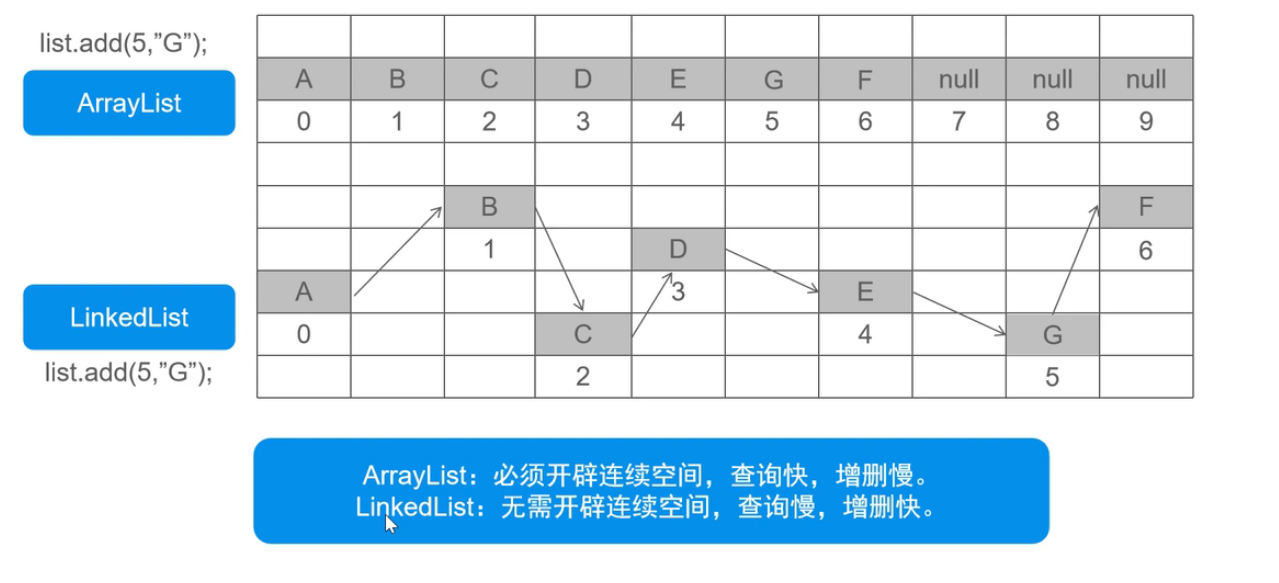
2.4泛型和工具类
-
Java泛型是JKD1.5中引入的新特性,其本质是参数化类型,把类型作为参数传递。
-
常见形式有:
- 泛型类、
- 泛型接口、
- 泛型方法。
-
语法:
- <T,…>T称为类型占位符,表示一种引用类型。
-
好处:
- 提高代码的重用性—一个方法可以传递任何类型的数据
- 防止类型转换异常,提高代码的安全性
2.4.1泛型类
package com.song.demo03;
public class TestGeneric {
public static void main(String[] args) {
//使用泛型类创建对象---
/* 注意:
1)T只能是引用类型
2)不同的泛型对象之间不能相互复制
*/
//String类型
MyGeneric<String> myGeneric = new MyGeneric<String>();
myGeneric.t = "hello";
myGeneric.show("大家好!");
String str = myGeneric.getT();
System.out.println(str);
//Integer
MyGeneric<Integer> myGeneric1 = new MyGeneric<>();
myGeneric1.t = 108;
myGeneric1.show(200);
Integer integer = myGeneric1.getT();
System.out.println(integer);
}
}
2.4.2泛型接口
接口:
package com.song.demo03;
//泛型接口
//语法:接口名<T>
//注意:不能使用泛型创建静态常量
public interface MyInterface<T> {
String name="张三";
T server(T t);
}
实现类一(实现接口时确定类型):
package com.song.demo03;
//接口的实现类,指明了泛型的类型
public class MyInterfaceImpl implements MyInterface<String> {
@Override
public String server(String s) {
System.out.println(s);
return s;
}
}
实现类二(实现接口时不确定类型):
package com.song.demo03;
//实现类实现接口时不确定类型,实现类的泛型就是接口的泛型
public class MyInterfaceImpl2<T> implements MyInterface<T> {
@Override
public T server(T t) {
System.out.println(t);
return t;
}
}
测试:
package com.song.demo03;
public class TestGeneric {
public static void main(String[] args) {
//泛型接口的两种实现方式
//1.实现类中指定类型
MyInterfaceImpl myInterface = new MyInterfaceImpl();
myInterface.server("songsong");
//2.把实现类变为泛型类,实例化时指定类型
MyInterfaceImpl2<Integer> myInterfaceImpl2 = new MyInterfaceImpl2<Integer>();
myInterfaceImpl2.server(1000);
}
}
2.4.3泛型方法
package com.song.demo03;
//泛型方法
//语法:<T> 返回值类型 方法名(){}
public class MyGenericMethod {
//泛型方法,该T只能在此方法中使用
public <T> void show(T t) {
T t2;//可以创建变量,但不能实例化(new)
t2 = t;
System.out.println("泛型方法:" + t);
}
}
package com.song.demo03;
public class TestGeneric {
public static void main(String[] args) {
//泛型方法
MyGenericMethod myGenericMethod = new MyGenericMethod();
myGenericMethod.show("中国加油");//不需要指明类型,直接传递想要的参数,根据参数类型决定
myGenericMethod.show(200);
myGenericMethod.show(3.1415926);
}
}
2.4.4泛型集合
- 概念:参数化类型、类型安全的集合,强制集合元素的类型必须一致。
- 特点:
- 编译时即可检查,而非运行时抛出异常
- 访问时,不必类型转换(拆箱)
- 不同泛型之间不能相互赋值,泛型不存在多态。
package com.song.demo03;
import com.song.demo02.Student;
import com.sun.org.apache.xerces.internal.impl.xpath.XPath;
import java.util.ArrayList;
import java.util.Iterator;
public class Demo01 {
public static void main(String[] args) {
/*ArrayList arrayList=new ArrayList<>();
arrayList.add("wangwu");
arrayList.add("zhangsan");
arrayList.add(0);
arrayList.add(20);
for (Object obj:arrayList ) {
System.out.println(obj);//没问题
String str=(String)obj;
//System.out.println(str);//有问题,类型转换异常
}*
*/
//使用泛型集合可以避免类型转换异常
ArrayList<String> arrayList = new ArrayList<String>();
arrayList.add("wangwu");
arrayList.add("zhangsan");
//arrayList.add(20);//直接不能添加,报错,避免后面再出问题
for (String str : arrayList) {
System.out.println(str);
}
ArrayList<Student> arrayList1 = new ArrayList<Student>();
Student s1 = new Student("张三", 21);
Student s2 = new Student("李四", 24);
Student s3 = new Student("王五", 20);
arrayList1.add(s1);
arrayList1.add(s2);
arrayList1.add(s3);
//arrayList1.add("zhangsan");//直接不能添加,报错,避免后面再出问题
Iterator<Student> it = arrayList1.iterator();
while (it.hasNext()) {
Student stu = it.next();//少了一步强制类型转换
System.out.println(stu.toString());
}
}
}
2.5Set子接口与实现类
-
特点:无序、无下标、元素不可重复。
-
方法:全部继承自Collection类
-
可以将set理解为不包含重复对象的collection
2.5.1Set 接口
package com.song.demo04;
import java.util.HashSet;
import java.util.Iterator;
import java.util.Set;
//测试Set接口
/**
* 特点:
* (1)无序,没有下标
* (2)不能重复
*/
public class Demo01 {
public static void main(String[] args) {
//创建集合
Set<String> set = new HashSet<String>();
//1.添加数据
set.add("苹果");
set.add("小米");
set.add("华为");
set.add("Oppo");
//set.add("华为");
System.out.println("元素个数:" + set.size());
System.out.println(set.toString());//无序--->打印顺序与添加顺序可能不一致
//2.删除
/*set.remove("小米");//无下标,不能通过下标删除
//set.clear();//清空
System.out.println("元素个数:" + set.size());
System.out.println(set.toString());
*/
//3.遍历【重点】
//3.1增强for
System.out.println("------------增强for----------");
for (String str : set) {
System.out.println(str);
}
//3.2迭代器
System.out.println("------------迭代器----------");
Iterator it = set.iterator();
while (it.hasNext()) {
System.out.println(it.next());
}
//4.判断
System.out.println("是否包含元素:" + set.contains("小米"));
System.out.println("集合是否为空:" + set.isEmpty());
}
}
2.5.2Set实现类
-
HashSet【重点】
-
存储结构:Hash表
-
基于HashCode计算元素存放位置
-
当存入元素的哈希码相同时,会调用equals()进行确认,如果认为值true,则拒绝后者存入。
-
-
TreeSet
- 存储结构:红黑树
- 基于排列顺序实现元素不重复
- 实现了SortedSet接口,对集合元素自动排序
- 元素对象的类型必须实现Comparable接口,指定排序规则。
- 通过CompareTo方法确定是否为重复元素。
(1)HashSet
存储过程:
- 根据hashCode计算保存的位置(数组),如果位置为空,则直接保存,如果不为空则执行第二步
- 再执行equals方法,如果equals方法位true,则认为是重复,否则形成链表
既有数组又有链表
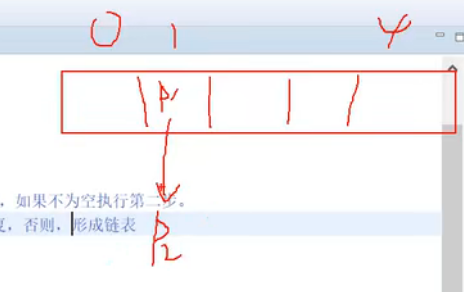
实例一:
package com.song.demo04;
import java.util.HashSet;
import java.util.Iterator;
//HashSet的使用
//存储结构:哈希表(数组+链表+红黑树)
public class Demo02 {
public static void main(String[] args) {
//新建集合
HashSet<String> hashSet = new HashSet<String>();
//1.添加元素
hashSet.add("张三");
hashSet.add("李四");
hashSet.add("王五");
hashSet.add("宋六");
System.out.println("元素个数:" + hashSet.size());
System.out.println(hashSet.toString());
//2.删除元素
/*hashSet.remove("王五");
hashSet.clear();//清空
System.out.println("删除后元素个数:" + hashSet.size());
System.out.println(hashSet.toString());
*/
//3.遍历
//3.1增强for
System.out.println("-------------------增强for------------");
for (String str : hashSet) {
System.out.println(str);
}
//3.2迭代器
System.out.println("-------------------迭代器------------");
Iterator it = hashSet.iterator();
while (it.hasNext()) {
System.out.println(it.next());
}
//4.判断
System.out.println("判断元素是否存在:" + hashSet.contains("李四"));
System.out.println("判断集合是否为空:" + hashSet.isEmpty());
}
}
实例二:
package com.song.demo04;
import java.util.Objects;
public class Person {
private String name;
private int age;
public Person(String name, int age) {
this.name = name;
this.age = age;
}
public String getName() {
return name;
}
public void setName(String name) {
this.name = name;
}
public int getAge() {
return age;
}
public void setAge(int age) {
this.age = age;
}
@Override
public String toString() {
return "Person{" +
"name='" + name + '\'' +
", age=" + age +
'}';
}
/*@Override
public boolean equals(Object o) {
if (this == o) {
return true;
}
if (o == null) {
return false;
}
if (o instanceof Person) {
Person person = (Person) o;
if (age == person.age && name.equals(person.getName()))
return true;
}
return false;
}
@Override
public int hashCode() {
//根据名字、年龄来计算hashCode,可以让相同值的的hashCode一致(既数组的同一位置)
int n1 = this.name.hashCode();
int n2 = this.age;//可以直接用年龄的数字,也可以对其做一定的加减等操作
//int n2 = this.age+31;//
//1)31是一个质数,减少散列冲突;2)31提高执行效率
return n1 + n2;
}
*/
//Alt+Insert 中有快速重写equals和hashCode的方法
@Override
public boolean equals(Object o) {
if (this == o) return true;
if (o == null || getClass() != o.getClass()) return false;
Person person = (Person) o;
return age == person.age && Objects.equals(name, person.name);
}
@Override
public int hashCode() {
return Objects.hash(name, age);
}
}
package com.song.demo04;
import java.util.HashSet;
import java.util.Iterator;
//HashSet的使用
//存储结构:哈希表(数组+链表+红黑树)
/**
* 存储过程:
* (1)根据hashCode计算保存的位置(数组),如果位置为空,则直接保存,如果不为空则执行第二步
* (2)再执行equals方法,如果equals方法位true,则认为是重复,否则形成链表
* (3)
*/
public class Demo03 {
public static void main(String[] args) {
//创建集合
HashSet<Person> person = new HashSet<>();
//1.添加元素
Person p1 = new Person("张三", 18);
Person p2 = new Person("李四", 26);
Person p3 = new Person("王五", 28);
Person p4 = new Person("宋六", 20);
person.add(p1);
person.add(p2);
person.add(p3);
person.add(p4);
//person.add(p4);//重复,不能再添加
person.add(new Person("宋六", 20));//可以添加,new了一个新的对象,地址不同,计算出的hashCode不同,可以直接存储
/**想根据值判断,则:
* 1)首先需重写hashCode()方法,让值相同的计算出的hashCode一样(数组的相同位置)---此时用equals判断地址,会形成链表
* 2)再重写equals方法,根据值判断是否一致,而非根据地址判断
*/
System.out.println("元素个数:" + person.size());
System.out.println(person.toString());
//2.删除元素
person.remove(p1);
person.remove(new Person("宋六", 20));//重写hashCode和equals后可以删除
System.out.println("删除之后元素个数:" + person.size());
System.out.println(person.toString());
//3.遍历元素
//3.1增强for
for (Person p : person) {
System.out.println(p.toString());
}
System.out.println("-------------");
//3.2迭代器
Iterator it = person.iterator();
while (it.hasNext()) {
System.out.println(it.next().toString());
}
//4.判断
System.out.println("元素是否存在" + person.contains(p2));
System.out.println("元素是否存在" + person.contains(new Person("李四", 26)));//重写hashCode和equals后可以根据值判断
System.out.println("集合是否为空" + person.isEmpty());
}
}
(2)TreeSet
- 存储结构:红黑树
- 基于排列顺序实现元素不重复
- 实现了SortedSet接口,对集合元素自动排序
- 元素对象的类型必须实现Comparable接口,指定排序规则。
- 通过CompareTo方法确定是否为重复元素。
红黑树是一个二叉查找树(每个节点最多只有2个子节点,且左节点小于右节点,涉及到比较)+颜色(保证左右平衡)
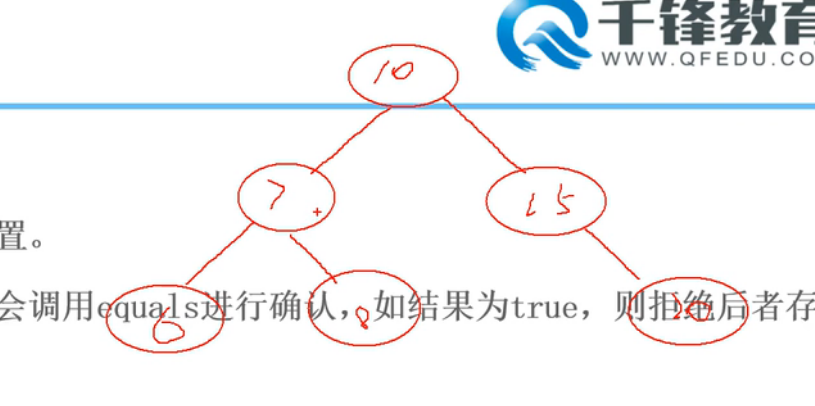
实例一:
package com.song.demo04;
//TreeSet的使用
//存储结构:红黑树
import java.util.Iterator;
import java.util.TreeSet;
public class Demo04 {
public static void main(String[] args) {
//创建集合
TreeSet<String> treeset = new TreeSet<>();
//1.添加元素
treeset.add("xyz");
treeset.add("abc");
treeset.add("hello");
treeset.add("song");
treeset.add("xyz");//重复,未添加
System.out.println("元素个数:" + treeset.size());
System.out.println(treeset.toString());//打印出的是按照字母表顺序排列的
//2.删除
treeset.remove("xyz");
System.out.println("元素个数:" + treeset.size());
System.out.println(treeset.toString());
//3.遍历
//3.1增强for
for (String str : treeset) {
System.out.println(str);
}
System.out.println("-------------------------");
//3.2迭代器
Iterator it = treeset.iterator();
while (it.hasNext()) {
System.out.println(it.next());
}
//4.判断
System.out.println("元素是否存在:" + treeset.contains("abc"));
System.out.println("集合是否为空:" + treeset.isEmpty());
}
}
实例二:
package com.song.demo04;
import java.util.Iterator;
import java.util.TreeSet;
//TreeSet的使用
//存储结构:红黑树
/**
* 要求:元素必须实现Comparable接口,compareTo()方法返回值为0,被认为是重复元素
*/
public class Demo05 {
public static void main(String[] args) {
//1.创建集合
TreeSet<Person> person = new TreeSet<>();
//1.添加元素
Person p1 = new Person("zhangsan", 18);
Person p2 = new Person("lisi", 26);
Person p3 = new Person("wangwu", 28);
Person p4 = new Person("lisi", 20);
//直接添加不成功,不知道如何把比较(二叉查找树要求左节点<右节点)
//需要实现Comparable接口,重写compareTo方法,告知比较规则
person.add(p1);
person.add(p2);
person.add(p3);
person.add(p4);
System.out.println("元素个数:" + person.size());
System.out.println(person.toString());//按照排序输出,先姓名后年龄,可自定义
//2.删除
/*person.remove(p1);
person.remove(new Person("lisi", 20));//实现Comparable接口之后,比较值,可以删除
System.out.println("删除之后元素个数:" + person.size());
System.out.println(person.toString());//按照排序输出,先姓名后年龄,可自定义
*/
//3.遍历
//3.1使用增强for
for (Person p : person) {
System.out.println(p.toString());
}
System.out.println("---------------------");
//3.2使用迭代器
Iterator it = person.iterator();
while (it.hasNext()) {
System.out.println(it.next().toString());
}
//4.判断
System.out.println(person.contains(p2));
System.out.println(person.contains(new Person("lisi", 20)));//可以判断
}
}
实例三:
package com.song.demo04;
import java.util.Comparator;
import java.util.TreeSet;
//TreeSet集合的使用
//Comparator接口:实现定制比较(比较器)
//Comparable:可比较的
public class Demo06 {
public static void main(String[] args) {
//创建集合,并指定比较规则
TreeSet<Person> person = new TreeSet<>(new Comparator<Person>() {//采用匿名内部类的方式
@Override
public int compare(Person o1, Person o2) {//拿两个对象定制比较规则
int n1 = o1.getAge() - o2.getAge();
int n2 = o1.getName().compareTo(o2.getName());
return n1 == 0 ? n2 : n1;//先比较年龄再比较性别
}
});
//1.添加元素
Person p1 = new Person("zhangsan", 18);
Person p2 = new Person("lisi", 26);
Person p3 = new Person("wangwu", 28);
Person p4 = new Person("lisi", 20);
person.add(p1);
person.add(p2);
person.add(p3);
person.add(p4);
System.out.println("元素个数:" + person.size());
System.out.println(person.toString());//按照排序输出,先姓名后年龄,可自定义
}
}
实例四:
package com.song.demo04;
import java.util.Comparator;
import java.util.TreeSet;
//要求:使用TreeSet集合实现字符串按照长度进行排序(最短的在前面,长度一样再根据字母顺序比较)
//使用Comparatar接口定制比较
public class Demo07 {
public static void main(String[] args) {
//创建集合
TreeSet<String> treeSet = new TreeSet<>(new Comparator<String>() {
@Override
public int compare(String o1, String o2) {
int n1 = o1.length() - o2.length();
int n2 = o1.compareTo(o2);
return n1 == 0 ? n2 : n1;
}
});
//1.添加元素
treeSet.add("hello world");
treeSet.add("abc");
treeSet.add("xyz");
treeSet.add("Beijing");
treeSet.add("zhangsang");
treeSet.add("lisi");
System.out.println(treeSet.size());
System.out.println(treeSet.toString());
}
}
3.Map接口与实现类
3.1Map集合体系结构
- Map集合主要用于存储键值对
- 键不允许重复(唯一),无序,无下标,不允许重复
- 值允许重复,无序,无下标
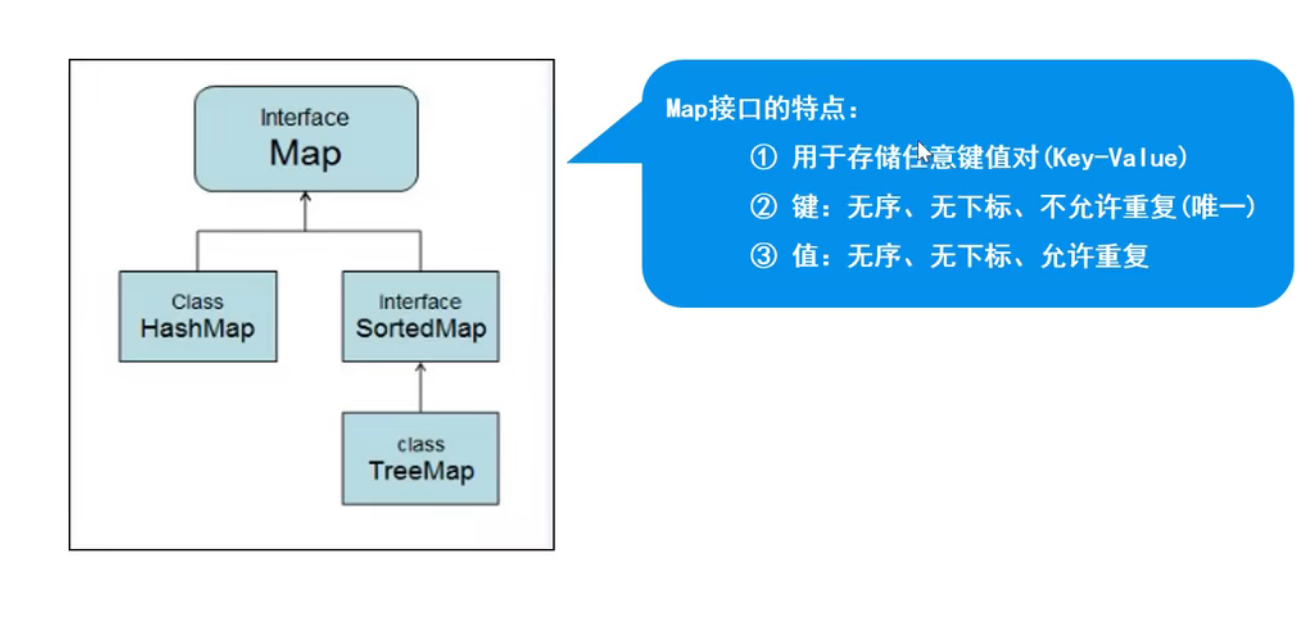
3.2Map父接口
- 特点:存储一对数据(Key-Value),无序、无下标,键不可重复,值可以重复。
- 方法:

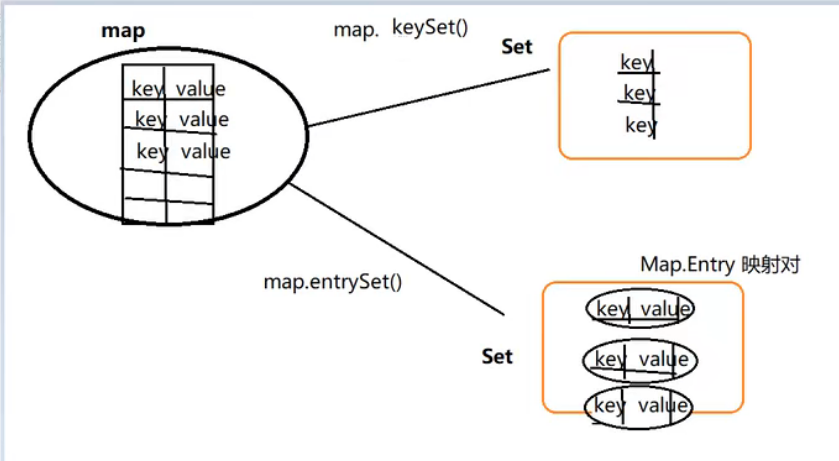
- entrySet()方法的效率要高于keySet()
使用实例:
package com.song.demo05;
//Map接口的使用
import java.util.HashMap;
import java.util.Map;
import java.util.Set;
/**
* 特点:
* (1)存储键值对
* (2)键不能重复
* (3)无序
*/
public class Demo01 {
public static void main(String[] args) {
//创建Map集合,需要指定Key和Value的类型
Map<String, String> map = new HashMap<>();
//1.添加元素
map.put("cn", "中国");
map.put("uk", "英国");
map.put("usa", "美国");
map.put("cn", "中华人民共和国");//key相同的,后面添加的value会把前面的覆盖掉
System.out.println("元素个数:" + map.size());
System.out.println(map.toString());
//2.删除元素
/*map.remove("usa");//通过键key来删除
System.out.println("元素个数:"+map.size());
System.out.println(map.toString());
*/
//3.遍历【遍历】
//3.1使用keySet(),得到的返回值是所有key的Set集合
System.out.println("----------------------keySet------------------");
//Set<String> keyset = map.keySet();//Set的类型就是key的类型
//for (String key : keyset) {
for (String key : map.keySet()) {
System.out.println(key + "------->" + map.get(key));//遍历的是所有key,再以此得到value
}
//3.2使用entrySet(),得到的返回值是由key,value组成的entry,构成的Set集合
System.out.println("----------------------entrySet------------------");
Set<Map.Entry<String, String>> entryset = map.entrySet();//接口Map.Entry要指明key和value的类型
for (Map.Entry<String, String> entry : entryset) {
System.out.println(entry.getKey() + "---------->" + entry.getValue());
}
//4.判断
System.out.println("key是否存在" + map.containsKey("cn"));
System.out.println("value是否存在" + map.containsValue("俄罗斯"));
}
}
3.3Map接口的实现类
-
HashMap【重点】
- JDK1.2版本,线程不安全(只能单线程下使用),运行效率快;允许用null作为key或者value。
-
HashTable
- JDK1.0版本,线程安全,运行效率慢;不允许null作为key或者value
-
Properties:
- Hashtable的子类,要求key和value都是String。通常用于配置文件的读取。
-
TreeMap
- 实现了SortedMap接口(是Map的子接口),可以对key自动排序。
3.3.1HadhMap
- HashMap【重点】
- JDK1.2版本,线程不安全(只能单线程下使用),运行效率快;允许用null作为key或者value。
- MapHash的初始默认容量是16,默认加载因子0.75(容量16,用到16*0.75=12时开始扩容),后续的每次扩容会扩大2倍,如16->32
- 当数组数组长度大于64且某处位置的链表长度大于8,则把链表调整为红黑树(树的查找遍历更快)
- 当链表(树?)长度小于6时,把红黑树调整回链表。
(1)源码分析
static final int DEFAULT_INITIAL_CAPACITY = 1 << 4; //HashMap的初始容量大小 2的4次方
static final int MAXIMUM_CAPACITY = 1 << 30;//HashMap的数组最大容量 2的30次方
static final float DEFAULT_LOAD_FACTOR = 0.75f;//默认加载因子
static final int TREEIFY_THRESHOLD = 8;//jdk1.8 当链表长度大于8时,调整为红黑树
static final int UNTREEIFY_THRESHOLD = 6;//jdk1.8 当链表长度小于6时,调整回链表
static final int MIN_TREEIFY_CAPACITY = 64;//jdk1.8 当链表长度大于8时,并且集合元素个数大于等于64时,调整为红黑树
transient Node<K,V>[] table;//数组
size;//元素个数
//刚创建HashMap后,还未添加任何元素时,table=null,size=0
//添加第一个元素时,容量才变为16------
//目的:为了节省空间

构造方法:
public HashMap() {
this.loadFactor = DEFAULT_LOAD_FACTOR; // all other fields defaulted
}
put方法:
public V put(K key, V value) {
return putVal(hash(key), key, value, false, true);
}
总结:
- HashMap刚创建时,table是null,是为了节省空间,当添加第一个元素时,table容量调整为16
- 当元素个数大于阈值(16*0.75=12)时,会进行扩容,扩后大小变为原来的2倍,目的是减少调整元素的个数。
- jdk1.8 当每个链表长度大于8,并且元素个数大于等于64时,会调整为红黑树,目的是提高执行效率
- jdk1.8 当链表长度小于6时,调整为链表
- jdk1.8以前,链表时是插入,jdk1.8以后链表是尾插入
HashSet与HashMap的区别:
HashSet里面本质用的就是HashMap
public HashSet() {
map = new HashMap<>();
}
(2)使用实例
package com.song.demo05;
import java.util.Objects;
public class Student {
private String name;
private int stuNo;
public Student() {
}
public Student(String name, int stuNo) {
this.name = name;
this.stuNo = stuNo;
}
public String getName() {
return name;
}
public void setName(String name) {
this.name = name;
}
public int getStuNo() {
return stuNo;
}
public void setStuNo(int stuNo) {
this.stuNo = stuNo;
}
@Override
public String toString() {
return "Student{" +
"name='" + name + '\'' +
", stuNo=" + stuNo +
'}';
}
@Override
public boolean equals(Object o) {
if (this == o) return true;
if (o == null || getClass() != o.getClass()) return false;
Student student = (Student) o;
return stuNo == student.stuNo && Objects.equals(name, student.name);
}
@Override
public int hashCode() {
return Objects.hash(name, stuNo);
}
}
package com.song.demo05;
import java.util.HashMap;
import java.util.Map;
/**
* HashMap的使用:
* 存储结构:哈希表(数组+链表+红黑树)
* <p>
* 元素增加时重复的判断依据:
* 使用key的hashcode和equals作为重复依据(默认用得是地址比较)
* 要想根据值比较,需要重写hashcode和equals
*/
public class Demo02 {
public static void main(String[] args) {
//创建集合
HashMap<Student, String> hashmap = new HashMap<Student, String>();
//1.增加元素
Student s1 = new Student("张三", 213);
Student s2 = new Student("李四", 104);
Student s3 = new Student("王五", 890);
Student s4 = new Student("六六", 432);
hashmap.put(s1, "北京");
hashmap.put(s2, "上海");
hashmap.put(s3, "南京");
hashmap.put(s4, "青岛");
//hashmap.put(s4, "大同");//不允许key重复,不能添加新的键值对,只会覆盖原来的value
hashmap.put(new Student("李四", 104), "杭州");//可以添加新的键值对,比较的是地址,认为key不同,故新增
//当重写hashcode和equals 方法后,比较的是值认为key重复,不能新增键值对,会覆盖原来的value
System.out.println("元素个数:" + hashmap.size());
System.out.println(hashmap.toString());
//2.删除元素
hashmap.remove(s1);
System.out.println("删除之后元素个数:" + hashmap.size());
System.out.println(hashmap.toString());
//3.遍历
//3.1使用keySet
for (Student stu : hashmap.keySet()) {
System.out.println(stu.toString() + "----->" + hashmap.get(stu));
}
System.out.println("------------------------");
//3.2使用entrySet
for (Map.Entry<Student, String> entry : hashmap.entrySet()) {
System.out.println(entry.getKey() + "------" + entry.getValue());
}
//4.判断
System.out.println("Key是否存在:" + hashmap.containsKey(s2));
System.out.println("value是否存在:" + hashmap.containsValue("杭州"));
}
}
3.3.2HashTable
-
HashTable—几乎不使用了
- JDK1.0版本,线程安全,运行效率慢;不允许null作为key或者value
- 默认初始容量11,默认加载因子0.75
-
Properties:-----与流的关系紧密,在流章节详细讲
- Hashtable的子类,要求key和value都是String。通常用于配置文件的读取。
3.3.3TreeMap
- TreeMap
- 实现了SortedMap接口(是Map的子接口),可以对key自动排序。
TreeSet与TreeMap的区别:
TreeSet本质就是通过TreeMap实现的。
public TreeSet() {
this(new TreeMap<E,Object>());
}
使用实例:
package com.song.demo05;
import java.util.Objects;
public class Student implements Comparable<Student> {
private String name;
private int stuNo;
public Student() {
}
public Student(String name, int stuNo) {
this.name = name;
this.stuNo = stuNo;
}
public String getName() {
return name;
}
public void setName(String name) {
this.name = name;
}
public int getStuNo() {
return stuNo;
}
public void setStuNo(int stuNo) {
this.stuNo = stuNo;
}
@Override
public String toString() {
return "Student{" +
"name='" + name + '\'' +
", stuNo=" + stuNo +
'}';
}
@Override
public boolean equals(Object o) {
if (this == o) return true;
if (o == null || getClass() != o.getClass()) return false;
Student student = (Student) o;
return stuNo == student.stuNo && Objects.equals(name, student.name);
}
@Override
public int hashCode() {
return Objects.hash(name, stuNo);
}
@Override
public int compareTo(Student o) {
int n2 = this.stuNo - o.stuNo;
return n2;//直接比较学号
}
}
1)实现Comparable接口实现比较
package com.song.demo05;
import java.util.Map;
import java.util.TreeMap;
/**
* TreeMap的使用
* 存储结构:红黑树(左节点<右节点)
* 两种比较方式:
* 1)实现Comparable接口
* 2)定制比较Comparator
*/
public class Demo03 {
public static void main(String[] args) {
//新建集合
TreeMap<Student, String> treemap = new TreeMap<>();
//1.增加元素
Student s1 = new Student("张三", 213);
Student s2 = new Student("李四", 104);
Student s3 = new Student("王五", 890);
Student s4 = new Student("六六", 432);
treemap.put(s1, "北京");
treemap.put(s2, "上海");
treemap.put(s3, "南京");
treemap.put(s4, "青岛");
//直接添加出现类型转换异常,不能Comparable,不能比较左右节点
//要求Student实现一个Comparable接口,指定比较规则,实现可比较,才能添加
treemap.put(new Student("六六", 432), "深圳");//不能添加,实现Comparable接口后制定了按照学号比较,此时学号一样,则认为key重复,故value会覆盖原来的值
System.out.println("元素个数:" + treemap.size());
System.out.println(treemap.toString());
//2.删除
treemap.remove(s3);
treemap.remove(new Student("六六", 432));//按照学号比较,可以删除
System.out.println("元素个数:" + treemap.size());
System.out.println(treemap.toString());
//3.遍历
//3.1使用keySet
for (Student stu : treemap.keySet()) {
System.out.println(stu.toString() + "----" + treemap.get(stu));
}
System.out.println("----------------------------------");
//3.2使用entrySet
for (Map.Entry<Student, String> entry : treemap.entrySet()) {
System.out.println(entry.getKey() + "-----" + entry.getKey());
}
//4.判断
System.out.println(treemap.containsKey(s2));
System.out.println(treemap.containsValue(213));
}
}
2)通过Comparator实现定制比较
//新建集合
TreeMap<Student, String> treemap = new TreeMap<Student, String>(new Comparator<Student>() {
@Override
public int compare(Student o1, Student o2) {
int n1 = o1.getStuNo() - o2.getStuNo();
return n1;//只根据学号比较
}
});
4.Collections工具类
- 概念:集合工具类,定义除了存取以外的集合常用方法。
- (相比Collection,多了一个s)
- 方法:

实例:
package com.song.demo05;
import java.util.*;
/**
* Collection工具类的使用
*/
public class Demo05 {
public static void main(String[] args) {
List<Integer> list = new ArrayList<>();
list.add(20);
list.add(25);
list.add(39);
list.add(11);
list.add(22);
list.add(40);
list.add(18);
System.out.println("排序之前" + list.toString());
//sort排序方法
Collections.sort(list);//从小到大
System.out.println("排序之后" + list.toString());
//binarySearch二分查找
int i = Collections.binarySearch(list, 39);//返回值是int类型,能找到则返回位置,未找到则返回值小于0
System.out.println(i);
//copy复制
List<Integer> dest = new ArrayList<>();
//Collections.copy(dest, list);//直接copy有问题,要求dest的大小与list相同
for (int i1 = 0; i1 < list.size(); i1++) {
dest.add(0);
}
Collections.copy(dest, list);//可以先给dest赋值0,使两个列表size一致,再赋值
System.out.println(dest.toString());
//reverse反转
Collections.reverse(list);
System.out.println(list.toString());
//shuffle打乱
Collections.shuffle(list);
System.out.println(list.toString());
//补充:list转成数组
System.out.println("list转成数组");
Integer[] array = list.toArray(new Integer[0]);//返回值是数组;构造时new的Interger长度无所谓,只是为了指明一种类型
System.out.println(array.length);
System.out.println(Arrays.toString(array));
//补充:数组转成集合
System.out.println("数组转成集合");
String[] name = {"张三", "李四", "王五", "刘六"};
List<String> list2 = Arrays.asList(name);
//数组转出来的集合是受限集合,不能添加和删除元素,不能add和remove
System.out.println(list2.size());
System.out.println(list2.toString());
//把基本类型的数组转成集合是,需要修改为包装类型(引用类型)
Integer[] nums = {12, 4, 2, 1, 44, 456, 34};
List<Integer> list3 = Arrays.asList(nums);
System.out.println(list3.size());
}
}
总结:
-
集合的概念:
- 对象的容器,和数组类似,定义了对多个对象进行操作的常用方法
-
List集合:
- 有序、有下标、元素可以重复(ArrayList、LinkedList、Vector)
-
Set集合:
- 无序、无下标、元素不可重复(HashSet、TreeSet)
-
Map集合:
- 存储一对数据,无序、无下标,键不可重复,值可以重复(HashMap、HashTable、TreeMap)
-
Collections:
list.add(25);
list.add(39);
list.add(11);
list.add(22);
list.add(40);
list.add(18);
System.out.println(“排序之前” + list.toString());
//sort排序方法
Collections.sort(list);//从小到大
System.out.println(“排序之后” + list.toString());//binarySearch二分查找 int i = Collections.binarySearch(list, 39);//返回值是int类型,能找到则返回位置,未找到则返回值小于0 System.out.println(i); //copy复制 List<Integer> dest = new ArrayList<>(); //Collections.copy(dest, list);//直接copy有问题,要求dest的大小与list相同 for (int i1 = 0; i1 < list.size(); i1++) { dest.add(0); } Collections.copy(dest, list);//可以先给dest赋值0,使两个列表size一致,再赋值 System.out.println(dest.toString()); //reverse反转 Collections.reverse(list); System.out.println(list.toString()); //shuffle打乱 Collections.shuffle(list); System.out.println(list.toString()); //补充:list转成数组 System.out.println("list转成数组"); Integer[] array = list.toArray(new Integer[0]);//返回值是数组;构造时new的Interger长度无所谓,只是为了指明一种类型 System.out.println(array.length); System.out.println(Arrays.toString(array)); //补充:数组转成集合 System.out.println("数组转成集合"); String[] name = {"张三", "李四", "王五", "刘六"}; List<String> list2 = Arrays.asList(name); //数组转出来的集合是受限集合,不能添加和删除元素,不能add和remove System.out.println(list2.size()); System.out.println(list2.toString()); //把基本类型的数组转成集合是,需要修改为包装类型(引用类型) Integer[] nums = {12, 4, 2, 1, 44, 456, 34}; List<Integer> list3 = Arrays.asList(nums); System.out.println(list3.size());}
}
# 总结:
- 集合的概念:
- 对象的容器,和数组类似,定义了对多个对象进行操作的常用方法
- List集合:
- 有序、有下标、元素可以重复(ArrayList、LinkedList、Vector)
- Set集合:
- 无序、无下标、元素不可重复(HashSet、TreeSet)
- Map集合:
- 存储一对数据,无序、无下标,键不可重复,值可以重复(HashMap、HashTable、TreeMap)
- Collections:
- 集合工具类,定义除了存取以外的集合常用方法






















 4262
4262











 被折叠的 条评论
为什么被折叠?
被折叠的 条评论
为什么被折叠?








